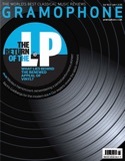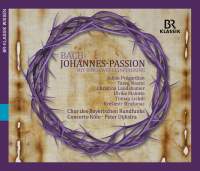Texte paru dans: / Appeared in: |
|
|
Outil de traduction (Très approximatif) |
|
|
Reviewer:
David Vickers
The Bavarian Radio Chorus under Peter Dijkstra add the St John Passion to their discography of major Baroque oratorios. The edition used is the standard modern conflation of Bach’s original 1724 score, the abandoned 1739 revision of the first part and a few elements from the final 1749 version. This means there are no surprises regarding text, and the live recording, taken from a series of concerts at Munich’s Herkulessaal, is an accomplished and satisfying experience.
From the outset of ‘Herr, unser Herrscher’, the driving bass-lines, turbulently swirling strings, wailing oboes and crisp harpsichord continuo of Concerto Köln establish this as an emotionally engaging performance. The Bavarian Radio Chorus’s disciplined precision in vigorous fugues and vividly characterised turba choruses will appeal to those who like some old-fashioned gutsiness and broad sonorities aligned to period-instrument textures directed with a sure hand. For example, the rustling orchestral details and flexible choral declamation in ‘Lasset uns den nicht zerteilen’ are delineated astutely.
Julian Prégardien’s authoritative Evangelist drips with integrity and sensitivity as each stage of the Passion demands. His honeyed delivery of Peter’s bitter weeping is breathtaking, and the rending of the Temple has booming ominousness; on both occasions it seems a bit anticlimactic when another tenor soloist suddenly pops up to sing the ensuing movement, although Tilman Lichdi does a creditable job throughout (‘Erwäge’ has Concerto Köln’s expertly balanced solo strings on compelling form). Tareq Nazmi’s resonant bass is a bolder Christus than one often hears. Christina Landshamer’s lithe singing in ‘Ich folge dir gleichfalls’ is an ideal match for the warm texture of two unison flutes with firmly bowed string basses and archlute continuo. Dijkstra’s use of contrafagotto (not quite as pianissimo as usual), gently rolling broken chords from the archlute and muted violins in ‘Betrachte, meine Seel’ creates an enthralling texture in support of Kre≈imir StraΩanac’s compassionate singing. The tender partnership between mezzo-soprano Ulrike Malotta and Jan Freiheit’s viola da gamba obbligato in ‘Es ist vollbracht’ is contrasted with brightly valorous violins in the fast section. Those who admire streamlined approaches – whether big or small – might find that Dijkstra overcooks the recipe now and then, for example with deliberately sculpted rubato in the elegantly moulded chorales, but there is nothing perfunctory about the tangible sense of occasion captured in this reading. |
|
|
|
|
|
Cliquez l'un ou l'autre
bouton pour découvrir bien d'autres critiques de CD |
|




